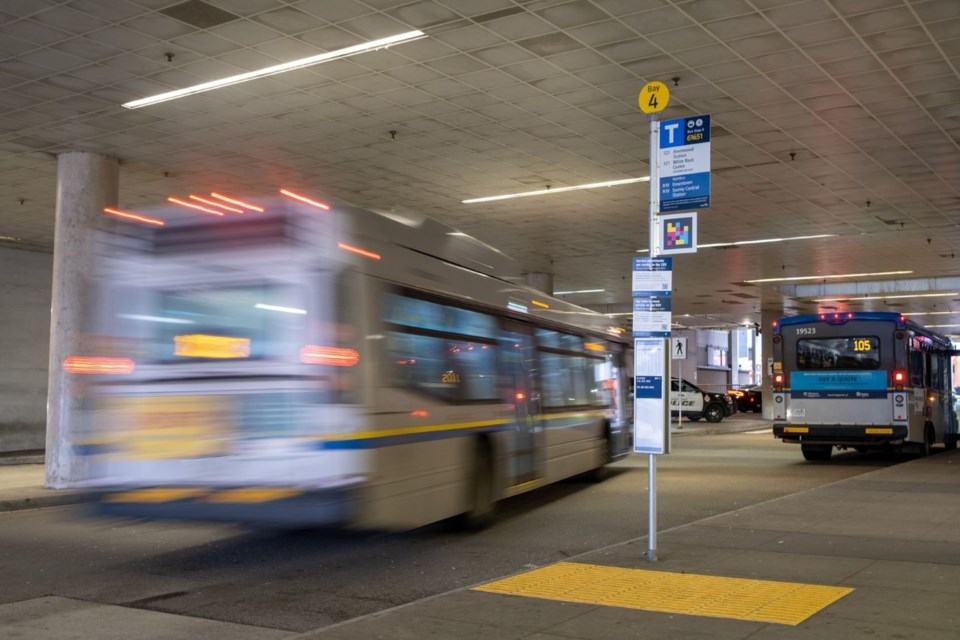New Westminster is part of a TransLink pilot project striving to help customers with sight loss.
The tool – the first of its kind in Canada – is designed to help customers with sight loss to better navigate the transit system independently.
Starting in late February, customers can download the NaviLens app through the Apple Store or Google Play to scan specialized coded decals, resembling QR codes, at three transit locations in Metro Vancouver. Once the decals are scanned, the app provides audio instructions that guide customers to bus stops and exact points of pick-up; the app can also identify nearby amenities, such as elevators and can provide real-time information alerts.
TransLink said the audio way-finding tool allows customers with sight loss to easily obtain information from the codes: Codes can be scanned from up to 14 metres away; no focus is required to scan codes; codes can be scanned in all light conditions; and the app can be used while the customer is moving.
“By bringing this advanced way-finding technology to Canada for the first time, we’re aiming to create a more inclusive experience and empower our riders to navigate the transit system with ease and safety,” TransLink CEO Kevin Quinn said in a news release. “These types of innovative projects demonstrate our commitment to improving accessibility for all customers throughout the region.”
According to TransLink, the NaviLens system is in use around the world – in cities such as New York City, Liverpool and Madrid – to help people with sight loss find their way in public spaces, including transit systems, rail stations and shopping centres.
Sixteen NaviLens codes have been installed at three TransLink locations: 10 bus bays at New Westminster SkyTrain station; four bus stops near the CNIB office at Sixth and Sixth in uptown New West; and two bus stops near the VCC campus on East Broadway in Vancouver.
Thor Diakow, a senior media relations advisor with TransLink, said New Westminster was selected to allow the project to be piloted in a more complex setting and to fully test the app’s capabilities.
“New Westminster has 10 bus bays that are quite spread out and not just in one corridor. The station also includes a shopping centre, increasing the likelihood of more people travelling in and out of it,” he said. “Additionally, New Westminster connects the SkyTrain to bus routes near the Canadian National Institute for the Blind.”
The Accessible Navigation Project will run for six months and will be evaluated for future expansion throughout the region. For more information or to participate in the pilot, visit translink.ca/accessnav.
For the Accessible Navigation Project, TransLink said it’s worked closely with its Access Transit Users’ Advisory Committee, which consists of members of the vision loss community.
“Implementing this test technology shows TransLink is working to ensure its customers with sight loss can travel independently and confidently,” said Rob Sleath, president of Access for Sight-Impaired Consumers, in a news release. “This project aims to enhance the abilities of those with sight loss by helping them travel throughout the TransLink system.”
Diakow said TransLink consistently works with vision loss communities and organizations to increase accessibility on the system. He said TransLink has engaged with the Canadian National Institute of the Blind (CNIB), Vision Loss Rehabilitation Canada, Alliance for the Equality of Blind Canadians, Canadian Council of the Blind, as well as TransLink’s Access Transit Users’ Advisory Committee to further this mandate.
Getting input
In 2018, TransLink conducted an online survey and sought direct input from members of the vision loss community in Metro Vancouver, with the purpose of learning more about how people who are blind, partially sighted or deafblind use TransLink’s bus services. The development of this approach included direct engagement with CNIB, Vision Loss Rehabilitation Canada, Alliance for the Equality of Blind Canadians, Canadian Council of the Blind, and TransLink’s Access Transit Users’ Advisory Committee.
TransLink states that this survey and the direct feedback received from stakeholders informed its approach, and was approved by the TransLink Board in 2019, for improving the accessibility of the transit system for people with sight loss.
These improvements include: tactile walking surface indicators on TransLink-owned and leased property; dual-format braille and tactile signage; and a pilot to test wayfinding technology (the Accessible Navigation Project). Last year, TransLink began installing braille signage at every bus stop – roughly 8,400 – throughout Metro Vancouver, and it’s also started installing the tactile walking surface indicators.
Coun. Jaimie McEvoy said people with sight issues have told him of the difficulties they have in navigating transit, particularly on SkyTrain and at SkyTrain stations.
“It’s a welcome initiative,” he said.
While he supports the Accessible Navigation Project initiative, McEvoy said other efforts need to be made to the transit system to improve accessibility.
“One thing I would say with TransLink is that while access initiatives are great, their overall maintenance and renewal of those things haven’t been great. So, for example, the yellow lines at SkyTrain stations aren’t just there for everyone’s safety, they are there because they are more visible for the sight impaired; some of those are long since faded, with no apparent ongoing or maintenance standard that has to be met. Elevators and escalators for access that are sometimes not working for long periods of time. HandyDart with sometimes long wait times,” he said. “So, I think the pilot project is a good, but in the overall scheme of things, TransLink really needs to make the current access measures effective, consistent and reliable.”
Follow Theresa McManus on Twitter @TheresaMcManus
Email [email protected]


